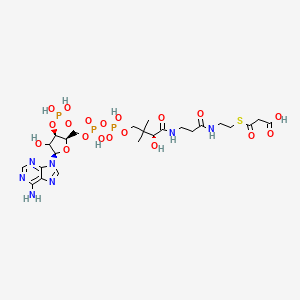| MeSH term | MeSH ID | Detail |
|---|---|---|
| Diabetes Mellitus | D003920 | 90 associated lipids |
| Adenocarcinoma | D000230 | 166 associated lipids |
| Reperfusion Injury | D015427 | 65 associated lipids |
| Diabetes Mellitus, Type 2 | D003924 | 87 associated lipids |
| Fatty Liver | D005234 | 48 associated lipids |
| Ketosis | D007662 | 13 associated lipids |
| Body Weight | D001835 | 333 associated lipids |
| Heart Failure | D006333 | 36 associated lipids |
| Prostatic Neoplasms | D011471 | 126 associated lipids |
| Hypothyroidism | D007037 | 32 associated lipids |
Lmfa07050031
Lmfa07050031 is a lipid of Fatty Acyls (FA) class. The involved functions are known as Pigment and Polymerization. The related lipids are Propionate.
Cross Reference
Introduction
To understand associated biological information of Lmfa07050031, we collected biological information of abnormalities, associated pathways, cellular/molecular locations, biological functions, related genes/proteins, lipids and common seen animal/experimental models with organized paragraphs from literatures.
What diseases are associated with Lmfa07050031?
There are no associated biomedical information in the current reference collection.
Possible diseases from mapped MeSH terms on references
We collected disease MeSH terms mapped to the references associated with Lmfa07050031
PubChem Associated disorders and diseases
What pathways are associated with Lmfa07050031
There are no associated biomedical information in the current reference collection.
PubChem Biomolecular Interactions and Pathways
Link to PubChem Biomolecular Interactions and PathwaysWhat cellular locations are associated with Lmfa07050031?
There are no associated biomedical information in the current reference collection.
What functions are associated with Lmfa07050031?
Related references are published most in these journals:
| Function | Cross reference | Weighted score | Related literatures |
|---|
What lipids are associated with Lmfa07050031?
Related references are published most in these journals:
| Lipid concept | Cross reference | Weighted score | Related literatures |
|---|
What genes are associated with Lmfa07050031?
There are no associated biomedical information in the current reference collection.
What common seen animal models are associated with Lmfa07050031?
There are no associated biomedical information in the current reference collection.
NCBI Entrez Crosslinks
All references with Lmfa07050031
Download all related citations| Authors | Title | Published | Journal | PubMed Link |
|---|---|---|---|---|
| Peluso G et al. | Differential carnitine/acylcarnitine translocase expression defines distinct metabolic signatures in skeletal muscle cells. | 2005 | J. Cell. Physiol. | pmid:15515015 |
| Oguro S et al. | Probing biosynthesis of plant polyketides with synthetic N-acetylcysteamine thioesters. | 2004 | Biochem. Biophys. Res. Commun. | pmid:15530429 |
| Nicot C et al. | C75 activates malonyl-CoA sensitive and insensitive components of the CPT system. | 2004 | Biochem. Biophys. Res. Commun. | pmid:15541339 |
| Raney MA et al. | AMPK activation is not critical in the regulation of muscle FA uptake and oxidation during low-intensity muscle contraction. | 2005 | Am. J. Physiol. Endocrinol. Metab. | pmid:15547141 |
| Yu X et al. | Leptinomimetic effects of the AMP kinase activator AICAR in leptin-resistant rats: prevention of diabetes and ectopic lipid deposition. | 2004 | Diabetologia | pmid:15578153 |
| Liu H et al. | Cysteine-scanning mutagenesis of muscle carnitine palmitoyltransferase I reveals a single cysteine residue (Cys-305) is important for catalysis. | 2005 | J. Biol. Chem. | pmid:15579906 |
| Shirai Y et al. | Metabolic regulation of leptin production in adipocytes: a role of fatty acid synthesis intermediates. | 2004 | J. Nutr. Biochem. | pmid:15590268 |
| Foster DW | The role of the carnitine system in human metabolism. | 2004 | Ann. N. Y. Acad. Sci. | pmid:15590999 |
| Dulloo AG et al. | Substrate cycling between de novo lipogenesis and lipid oxidation: a thermogenic mechanism against skeletal muscle lipotoxicity and glucolipotoxicity. | 2004 | Int. J. Obes. Relat. Metab. Disord. | pmid:15592483 |
| Bian F et al. | Peroxisomal and mitochondrial oxidation of fatty acids in the heart, assessed from the 13C labeling of malonyl-CoA and the acetyl moiety of citrate. | 2005 | J. Biol. Chem. | pmid:15611129 |
| Jeong JC et al. | Exploiting the reaction flexibility of a type III polyketide synthase through in vitro pathway manipulation. | 2005 | J. Am. Chem. Soc. | pmid:15631450 |
| Taylor EB et al. | Long-chain acyl-CoA esters inhibit phosphorylation of AMP-activated protein kinase at threonine-172 by LKB1/STRAD/MO25. | 2005 | Am. J. Physiol. Endocrinol. Metab. | pmid:15644453 |
| Koves TR et al. | Subsarcolemmal and intermyofibrillar mitochondria play distinct roles in regulating skeletal muscle fatty acid metabolism. | 2005 | Am. J. Physiol., Cell Physiol. | pmid:15647392 |
| Oh W et al. | Glucose and fat metabolism in adipose tissue of acetyl-CoA carboxylase 2 knockout mice. | 2005 | Proc. Natl. Acad. Sci. U.S.A. | pmid:15677334 |
| Herrero L et al. | Alteration of the malonyl-CoA/carnitine palmitoyltransferase I interaction in the beta-cell impairs glucose-induced insulin secretion. | 2005 | Diabetes | pmid:15677504 |
| Abe I et al. | A plant type III polyketide synthase that produces pentaketide chromone. | 2005 | J. Am. Chem. Soc. | pmid:15686354 |
| Funa N et al. | A novel quinone-forming monooxygenase family involved in modification of aromatic polyketides. | 2005 | J. Biol. Chem. | pmid:15701630 |
| Rendina AR and Cheng D | Characterization of the inactivation of rat fatty acid synthase by C75: inhibition of partial reactions and protection by substrates. | 2005 | Biochem. J. | pmid:15715522 |
| Miyahisa I et al. | Efficient production of (2S)-flavanones by Escherichia coli containing an artificial biosynthetic gene cluster. | 2005 | Appl. Microbiol. Biotechnol. | pmid:15770480 |
| Oikawa S | [Is hyperfattyacidemia related to the occurrence of diabetes?]. | 2005 | Nippon Rinsho | pmid:15779455 |
